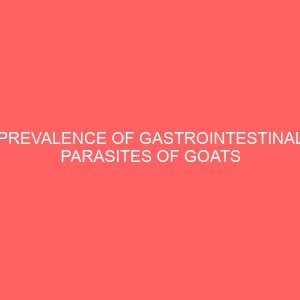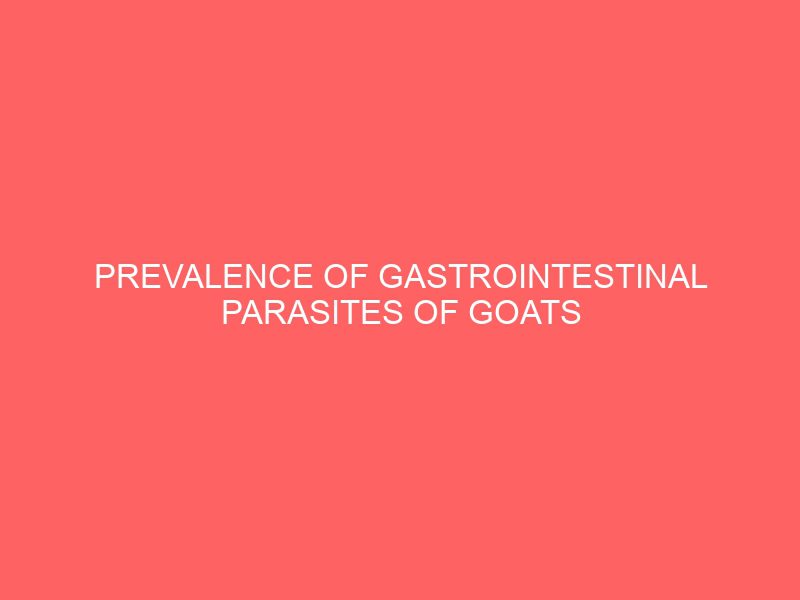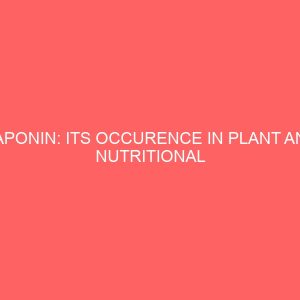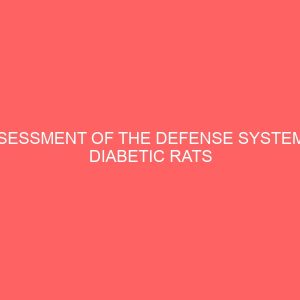Description
ABSTRACT
A total of 35 faecal samples of goats which comprised of twenty-one (21) matured female goat, two (2) matured male goat, five (5) female growers, five (5) male growers and two (2) castrated goat were collected from the University of Benin farm project . The faecal samples collected were analyzed for gastrointestinal parasitic infection using floatation and sedimentation method. From the result obtained, 26 (74.3%) samples were found positive for gastrointestinal parasitic helminth. The range of parasites found in this present study included five species of intestinal helminths which are; Strongyloides sp 17 (48.57%), Haemonchus contortus 1(2.86%),Trichuris ovis 1 (2.86%), Moniezia expansa 6 (17.14%), Fasciola hepatica 1 (2.86%). Nine 9(25.71%) of the goats examined were free of gastrointestinal helminth. This study revealed strongyloides and monieza expansa as the most common parasites of the goats examined and the prevalence of this gastrointestinal parasites could lead to great loss and decrease in productivity of these ruminants.
TABLE OF CONTENT
Title page ———–i
Abstract ———-ii
Acknowledgment ———-iii
Certification ———–iv
Dedication———–v
Table of content ———-vi
List of tables ———–viii
List of figures ———-ix
CHAPTER ONE
1.0INTRODUCTION ———1
1.1Objective———-2
CHAPTER TWO
2.0Literature Review———3
CHAPTER THREE
3.0Material and Method———15
3.1Materials Used———15
3.2Experimental Animals——–15
3.3Sample Collection———15
3.4Materials Used———15
3.5Sampling Technique———16
CHAPTER FOUR
4.0Result———-18
CHAPTER FIVE
5.0 Discussion———-30
6.0Conclusion———-33
6.1Recommendation———33
Reference———-34
LIST OF TABLES
Table1 :Comparison of the Prevalence of Gastro- Intestinal Helminth in Goat –18
LIST OF FIGURES
Figure1 Prevalence of Gastro- Intestinal Helminth in Goat —-20
Figure 2: Comparism Of Prevalence Of Gastro- Intestinal Helminth In Goat–21
Figure 3: Sex Distribution of M.expansa——-23
Figure 4: Sex Distribution of Strongyloides——-24
Figure 5: Sex Distribution of T.ovis——–25
Figure 6: Sex Distribution of H.contortus——-26
Figure 7: Sex Distribution of F.hepatica——-27
Figure 8: Percentages of Infected and Non-infected in all Categories of
Animal ———28
CHAPTER ONE
1.0INTRODUCTION
Animal agriculture is an indispensable pre-requisite towards the sustainability of human development because of food provision, employment generation, etc. Apart from serving as source of food for humans, animal agriculture is also important in providing non – food materials such as hides, skin, wool and feathers which are in turn used as raw materials for manufacturing other valuable products. Ajayi, e al (1998) Livestock production is faced with a number of constrains, which on the long run results in low productivity and reduce profitability. Anon, (2006).
According to Biu E.O and Leeflang P (2006), among these constrains are diseases; Animal diseases constitute a major obstacle to economic development as well as poising health, risk to livestock productivity and profitability, inadequate consumption of protein of animal origin, poverty, unemployment, low contribution to the nation’s gross domestic product among others.
Parasitism is a primary cause of production losses which results in mortality, reduction in weight gain, low fertility, losses in most livestock – producing countries of the world. Fabiyi, (1987)
Gastrointestinal parasites have been noted as major constraint to ruminants’ productivity in terms of pathology and economic importance. Gates et al.,, and Wescott et al.,(2003). These parasites are found within the gastro intestinal tract (GIT) of the animal. Several worms such as cestodes, nematodes and trematodes at different location within the gastrointestinal tract are responsible for the disease.
The general clinical signs of gastrointestinal parasites as noted by Love and Hutchinson, (2003), Otto, (2005), and Otto et al (2000) includes; weakness of the body, abdominal pains, anorexia, emaciation, potbelly, diarrhea, enteritis, anaemia, constipation, loss of weight, jaundice, rough hair coat, alopecia, coughing, labour breathing, fever, infertility, abortion and sudden death.Oluwafemi , Anosa (2000) also noted that decreased growth, weight loss in young growing calves and late maturity of slaughter stocks `are the major clinical signs in calves.
The direct losses caused by these parasites are attributed to acute illness and death, premature slaughter and rejection of some parts during meat inspection. Indirect losses includes the diminution of potential such as decreased growth rate, anaemia, weight loss in young growing calves and late maturity of slaughter stock, Oluwafemi, and Anosa, (2000) .
1.1Objective
The objective of this study is;
To isolate and identify the gastrointestinal parasites of goats in UNIVERSITY OF Benin Farm Project
To determine the prevalence of parasitic infection and its associating factors in the different sexes and age of goats.







